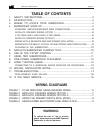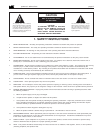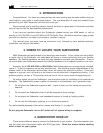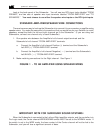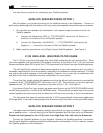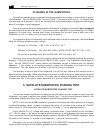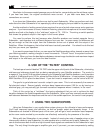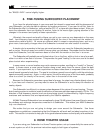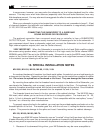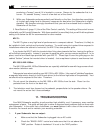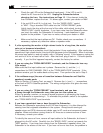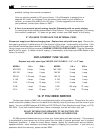
page 15powered subwoofers
c. Check the red LED on the Subwoofer's back panel. If the LED is not lit,
check the AC fuse next to the LED. Unplug the Subwoofer before
changing the fuse. See instructions on Page 15. If the element inside the
fuse is broken, replace the fuse. If it blows again, contact your dealer or M&K.
d. If the red LED is still lit, try this test: Turn the "BASS LEVEL" control
to "MIN". Plug a standard RCA cable into the "FROM PREAMP" jacks.
Lightly touch the plug at the free end of the cable, while slowly turning the
"BASS LEVEL" control clockwise. If you hear noise from the Subwoofer when
you touch the cable, the Subwoofer is functioning. Look elsewhere in your
system for the problem. If you hear no noise, contact your dealer or M&K.
e. Make sure that the input cables are OK. Double check your connections. If
necessary, replace any defective cables or speaker wires.
2. If, after operating the woofer at high volume levels for a long time, the woofer
cuts out or becomes intermittent:
Your Subwoofer has a protection circuit that protects it from overheating. After continuous
operation at high volume levels, this circuit kills the power to the Subwoofer. When it activates,
the sound may switch in and out rapidly, with a "fluttering" sound. If this happens, unplug the
unit and let it sit for at least half an hour. After that time, plug it back in. It should operate
normally. If you find this happens frequently, contact the factory for advice.
3. If you are using the "FROM AMPLIFIER" terminals, and the Subwoofer has very
little output:
Make sure that the input cables are in phase. Reverse the (+) and the ( — )
connections for ONE CHANNEL ONLY at the "FROM AMPLIFIER" terminals. If the
problem remains, put the cables back as they were. Then perform the test in Step 3.
3. If the midbass range (the area of transition between Subwoofer and Satellite
speakers) sounds weak:
Refer to Section 4, Phasing Test, on page 9. Reverse the (+) and ( — ) connections
at the back of BOTH Satellite speakers. The wiring configuration that gives the most
bass is correct.
4. If you are using the "FROM PREAMP" input terminals, and you hear
a thump through the Subwoofer every time you turn the system on:
Either the preamp, receiver, or surround sound processor is generating the thump,
and the Subwoofer is reproducing it. To eliminate this problem, switch to the speaker
wire "FROM AMPLIFIER" input terminals.
5. If you hear a persistent hum or buzz through the Subwoofer:
Because the Subwoofer reproduces the 60 Hz hum frequency, it is often blamed for
causing hum that originates elsewhere in the system. Always avoid running all
speaker wires and RCA interconnect cables near to AC cords and component power
supplies. Wires and cables running close to AC lines are a common source of hum.
If necessary, reroute your cables.
To identify the source of hum, remove all input cables to the Subwoofer, but leave it
plugged into the AC outlet. Carefully turn the "BASS LEVEL" control up towards the
"MAX" position. If you hear hum coming from the Subwoofer's speaker driver, the
Subwoofer is the source of the hum. If you hear no hum or less hum, the problem is




